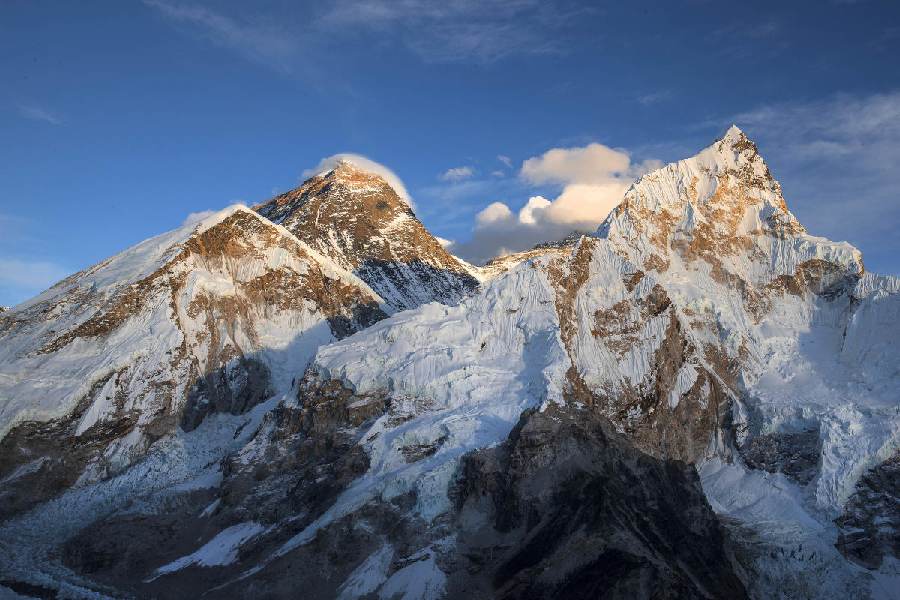Despite concerns about rising temperatures, melting glaciers and snow and increasing extreme weather events, the mountaineering community celebrated the 70th anniversary of scaling Mount Everest with around 500 climbers, including four Indians, making it to the summit in 2023.
Ever since New Zealander Edmund Hillary and Nepal’s Sherpa Tenzing Norgay summited the 8,848.86 metres (29,032 feet) high Mt Everest, a.k.a. Sagarmatha in Nepali, on May 29, 1953, thousands of climbers from across the globe, including India and Nepal, have been attracted to the highest peak in the world, scores of them reached the summit while many lost their lives.
Official data showed that since 1953’s Hillary-Norgay summit, around 7,000 mountaineers have successfully scaled Mt Everest while over 300 have lost their lives.
The year 2023 was no exception. A total of 478 climbers, including 103 females, summited Everest in the Spring of 2023, the only narrow window available to climb the extremely high altitudes.
Four Indian nationals stood atop Mt Everest and one died in the high mountains this year. Yashi Jain, Mithil Raju, Sunil Kumar and Pinkhi Haris Chhed successfully scaled the highest peak in the world on May 17.
Suzanne Leopoldina Jesus, an Indian mountaineer with a pacemaker, died near the Everest Base Camp while attempting to climb the peak on May 18.
Officials said 11 climbers, including four Nepalese, one Indian and one Chinese, died while eight went missing during their respective expeditions to Mt Everest.
Nepal’s Kami Rita Sherpa, 53, set a new world record of climbing Mt Everest 28 times with two summits this season on May 17 and May 23. Kami Rita’s record till 2022 was equalled by compatriot, Sherpa Pasang Dawa, 46, who made it to the highest peak for the 26th time this year on May 14 and the 27th time on May 17.
But it is not just the Sherpa community that continued to break records and test human endurance in the rarified air of the high-altitude Himalayas in Nepal.
Hari Budhamagar, 43, a double amputee ex-British Gurkha soldier scaled Mt Everest, scripted history by becoming the first in the category to scale the world's highest peak with artificial legs, on May 19.
On the same day, May 19, Shrinivas Sainis Dattatraya, 39, an Indian-origin Singaporean climber went missing while returning from the summit of Mount Everest.
No expedition in the high-altitude Himalayas is complete without the help of the Sherpa community that lives around the foothills of the snow-clad mountains. That also makes them the most vulnerable in the dangerous treks to the world’s highest mountain region.
Three Nepalese Sherpa guides – Themwa Tenzing Sherpa, Lakpa Rita Sherpa and Badure Sherpa – went missing on April 12 after a massive ice sheet of more than 50 metres tumbled down the mountain and buried them deep under five to six metres of snow on the most dangerous section of Mt Everest amidst an avalanche, making it the season's first accident at the world's tallest peak.
Nepal granted a record 466 climbing permits, including 40 from India, for Mt Everest this spring, from climbers from 65 different countries. This broke the previous record of 2021, which was 409. In 2022, the number was 323.
Mountaineering is a good revenue stream for the tiny Himalayan nation of Nepal with a large mountain community dependent on mountaineering and related tourism in the region.
And, therefore, the depleting glaciers, rising temperatures and increasing extreme rainfall events are a cause of worry for the large number of people whose livelihoods are at stake in the changing climate.
The International Centre for Integrated Mountain Development (ICIMOD) pointed out how 79 glaciers surrounding Everest have thinned by over 100 metres in just six decades, and the thinning rate has nearly doubled since 2009.
Coinciding with the 70th anniversary of the Mt Everest summit, ICIMOD, supported by mountain institutes globally, including the Nepal Mountaineering Association, called on the governments to make good on their commitments to limit global warming to 1.5 degrees as part of the #SaveOurSnow campaign.
Except for the headline, this story has not been edited by The Telegraph Online staff and has been published from a syndicated feed.










